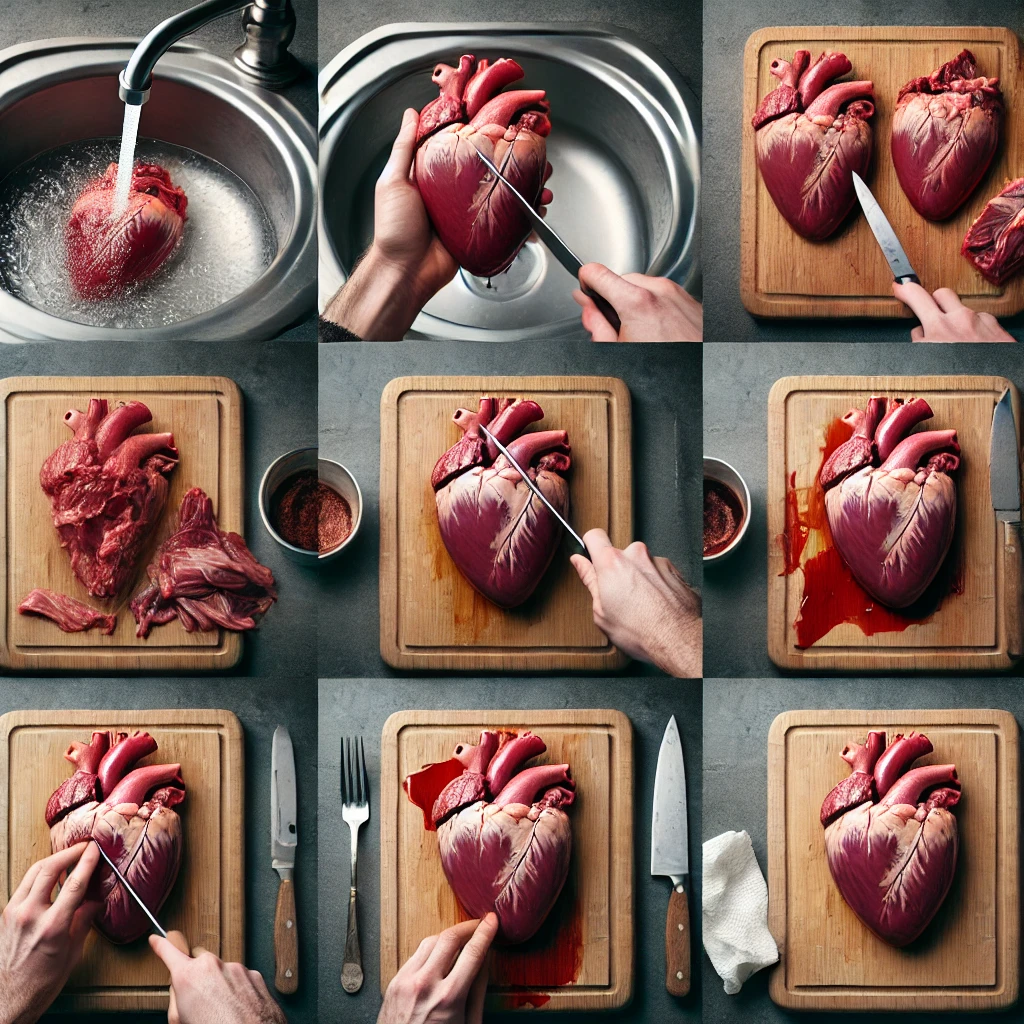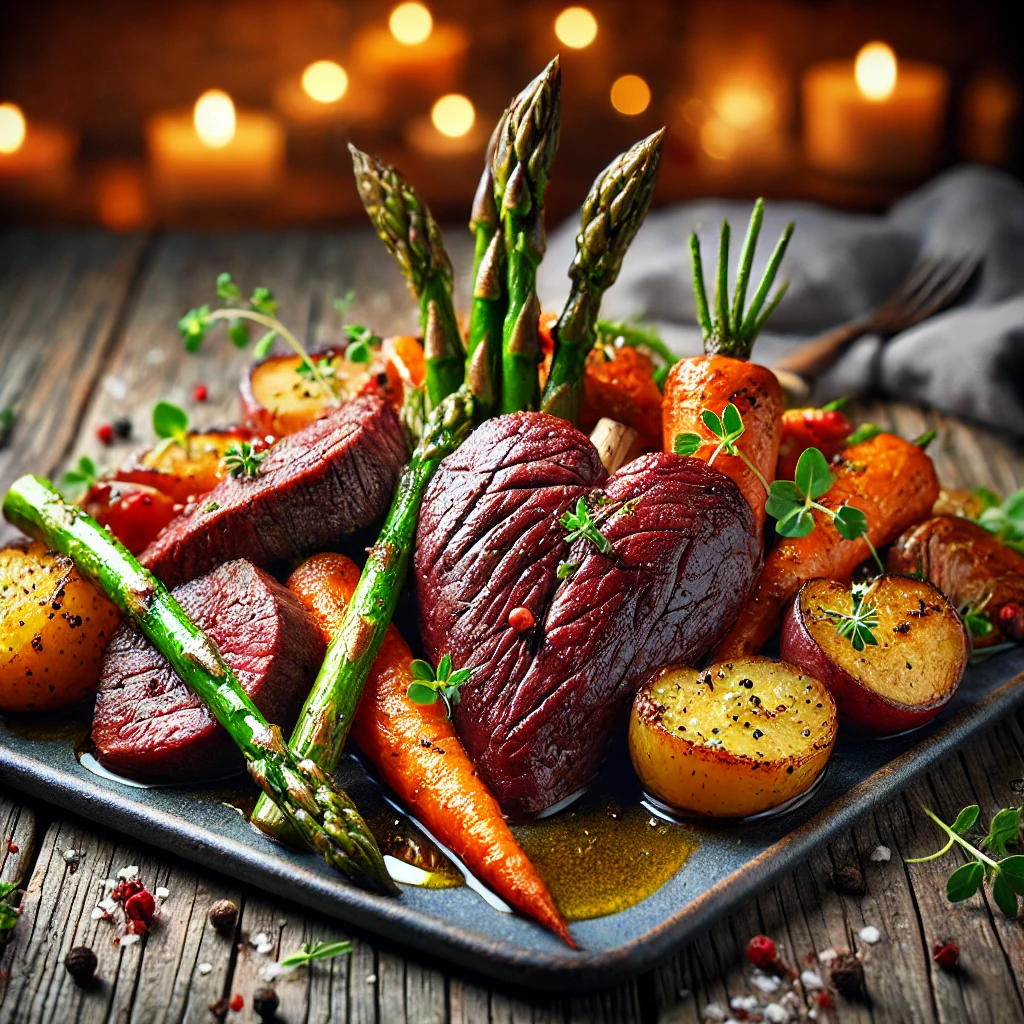Looking for a bold, protein-packed cut that goes beyond the usual?
This beef heart recipe transforms an overlooked organ into a tender, flavorful dish that’s surprisingly easy to prepare. With the right technique, beef heart becomes a lean and nutritious centerpiece, rich in iron, and full of character. If you’re ready to cook something different (and delicious), this one delivers.
Table of contents
Why Try a Beef Heart Recipe?
Rich Flavor of Beef Heart
- Beef heart has a savory and mild flavor that complements a wide range of recipes. Its taste is both rich and subtle, making it a versatile choice for hearty dishes.
- When prepared properly, the beef heart becomes tender and meaty, with a texture that’s satisfying and delicious. Cleaning and cooking it correctly unlocks its full potential.
Nutritional Benefits
- This beef heart recipe is loaded with protein, iron, and essential vitamins like B12, providing a healthy and nourishing meal. These nutrients are crucial for energy and overall health.
- As a nutrient-dense ingredient, beef heart supports balanced, energy-packed diets. It’s an excellent choice for those looking to add more wholesome and fulfilling foods to their meals.
Economical and Sustainable
- Beef heart is an affordable option compared to pricier beef cuts, offering great value without compromising quality. It’s an ideal choice for budget-conscious home cooks.
- Using beef heart helps reduce food waste by utilizing every part of the animal. Choosing this cut is not only economical but also a step towards more sustainable cooking.
For another affordable and protein-rich meal, try our diced chicken recipe, quick, healthy, and full of flavor
Ingredients for the Perfect Beef Heart Recipe
Main Ingredients
- This beef heart recipe starts with a fresh beef heart as the star ingredient, along with essential items like garlic, onions, olive oil, and fresh herbs like parsley or thyme. These basics create a foundation of rich and savory flavors.
- To ensure the best flavor and texture, clean the beef heart thoroughly, peel and mince the garlic, slice the onions thinly, and chop the herbs finely. High-quality, fresh ingredients will elevate the dish.
Optional Add-ons
- Enhance your recipe with red wine or beef stock to deepen the flavors. Additional spices like paprika, cumin, or chili flakes can also add a unique twist to the dish.
- Experiment with other ingredients like lemon zest for brightness or a touch of honey for sweetness to create your own variation of this classic beef heart recipe.
Ingredient Substitutions
- If you don’t have olive oil, substitute with butter for a richer taste. If fresh herbs aren’t available, dried versions work well; just use them in smaller amounts to avoid overpowering the dish.
- For dietary needs, try plant-based stock instead of beef stock or gluten-free seasonings for a more inclusive recipe. Flexibility with substitutions ensures that this beef heart recipe can work for everyone.
Preparing the Beef Heart
Cleaning and Trimming

- Rinse the Beef Heart
- Start by rinsing the beef heart under cold running water to remove any surface blood or residue. Pat it dry with paper towels.
- Inspect the Exterior
- Place the heart on a clean cutting board and examine it. You’ll notice a layer of fat and membranes on the outside that need to be removed.
- Remove the Fat
- Using a sharp knife, carefully trim away any large deposits of fat from the exterior. Work slowly to avoid cutting into the meat.
- Trim the Membranes
- Next, remove the tough, whitish membrane that covers the heart. Gently lift the membrane with the knife tip and slice it away in thin layers.
- Open the Chambers
- Slice the heart open to expose the inner chambers. Remove any visible veins or connective tissue inside. These parts can be tough and affect the texture.
- Cut Away Valves
- Inspect the upper portion of the heart where the valves are located. Trim away any remaining valves or sinewy material with precision.
- Final Rinse and Pat Dry
- Give the cleaned heart a final rinse to ensure all debris is removed. Pat it dry thoroughly to prepare it for slicing or marinating.
- Start by rinsing the beef heart under cold water to remove any residue. Use a sharp knife to carefully trim away fat, membranes, and valves. Removing these parts ensures the meat will be tender and pleasant to eat.
- Thorough cleaning is essential for a rich and balanced flavor. Take your time to prepare the beef heart properly, as this step sets the foundation for a successful beef heart recipe.
Cutting Techniques
- Slice the beef heart into thin, even pieces for uniform cooking. This ensures that all slices cook at the same rate and makes the meat tender and easy to chew.
- Depending on your recipe, you can cut the slices into smaller chunks or leave them as strips. Proper slicing is key to achieving the best results in this beef heart recipe.
Marinating for Flavor
- Marinate the beef heart to enhance its taste and tenderness. A simple marinade of olive oil, minced garlic, fresh herbs, and optional red wine or lemon juice works beautifully.
- Let the meat sit in the marinade for at least 30 minutes, or longer if time permits. This step infuses the beef heart with deep flavors, elevating the overall dish.
Cooking the Beef Heart
Searing the Meat
- Heat a cast iron skillet or heavy pan over high heat and add a small amount of olive oil or butter. Once the pan is hot, place the slices of beef heart in a single layer. Sear each side for 2–3 minutes to develop a golden crust that locks in the juices.
- Avoid overcrowding the pan, as this prevents proper browning. Searing is a crucial step in this beef heart recipe, adding depth and flavor to the dish.
Braising or Pan-Frying
- For a tender texture, braise the seared beef heart. Add beef stock, red wine, or water to the pan, reduce the heat to low, and cover. Let it simmer gently for 15–20 minutes. This slow cooking method infuses the heart with rich flavors.
- Alternatively, you can pan-fry the slices over medium heat, flipping occasionally, until fully cooked. This method is quicker and results in a crispier texture, perfect for those who prefer a firmer bite.
Finishing Touches
- Once cooked, add fresh herbs like parsley or thyme for a burst of color and freshness. A small knob of butter or a splash of lemon juice can enhance the flavor further.
- For an optional twist, deglaze the pan with red wine or stock to create a simple sauce. This step brings the flavors of the beef heart recipe together beautifully.
Looking for more straightforward, protein-packed ideas? Browse our full list of quick & easy recipes to save time without sacrificing flavor.
How to Serve Beef Heart
Side Dishes That Pair Well
- Pair this beef heart recipe with classic side dishes like creamy mashed potatoes or roasted vegetables. These hearty sides complement the rich, savory flavors of the beef heart.
- For a lighter option, serve it alongside a fresh green salad or steamed asparagus. The crisp textures and vibrant flavors balance the dish perfectly.
Garnishing and Presentation
- Garnish the beef heart with freshly chopped parsley or thyme for a pop of color and added freshness. A light drizzle of olive oil or melted butter can elevate the presentation.
- Add a slice of lemon or a sprinkle of lemon zest for a bright, tangy touch that enhances the overall flavor. Beautiful plating makes the dish even more appealing.
Beverage Pairings
- For a perfect pairing, serve this beef heart recipe with a robust red wine, such as Merlot or Cabernet Sauvignon. The bold flavors of the wine match the richness of the dish.
- If you prefer non-alcoholic options, try sparkling water with a splash of citrus or a refreshing iced tea. These drinks provide a clean contrast to the savory beef heart.
Storing and Reheating Beef Heart
Refrigerating Leftovers
- After enjoying your beef heart recipe, store any leftovers in an airtight container. Place it in the refrigerator and consume within 3 days to maintain freshness.
- Allow the beef heart to cool completely before sealing the container. This prevents excess moisture from affecting the texture and flavor of the meat.
Freezing Cooked Beef Heart
- To store for a longer period, freeze the cooked beef heart. Wrap individual portions tightly in plastic wrap or aluminum foil, then place them in a freezer-safe bag or container.
- Label the bag with the date and use within 3 months for the best quality. This ensures you’ll always have a delicious meal ready to reheat.
Reheating Instructions
- To reheat, use a skillet over low heat and add a splash of beef stock or water to keep the meat moist. Heat gently until warmed through without overcooking.
- Avoid microwaving on high heat, as it can make the meat tough. Instead, use lower power settings or reheat slowly on the stove for the best results.
Share Your Experience
- After making this beef heart recipe, share your feedback, photos, and creative variations with friends, family, or online communities. Hearing about others’ experiences can inspire even more ideas.
- Encouraging others to try this recipe can help build a community of home cooks who enjoy exploring delicious and unique meals like this one!
Love traditional meals with a twist? Explore more comforting dishes in our Grandma’s recipes collection.
Frequently Asked Questions (FAQs)
What does beef heart taste like?
Beef heart has a rich, meaty flavor that’s slightly milder than other organ meats. When cooked properly, it’s tender and has a texture similar to steak.
Is beef heart healthy?
Yes! Beef heart is highly nutritious, packed with protein, iron, and essential vitamins like B12. It’s a great choice for anyone looking to incorporate nutrient-dense ingredients into their diet.
How do I clean and prepare beef heart?
To prepare beef heart, rinse it under cold water, then trim away fat, membranes, and valves with a sharp knife. Proper cleaning ensures tenderness and improves the flavor.
Can I freeze beef heart?
Absolutely. Wrap the beef heart tightly in plastic wrap or aluminum foil, then store it in a freezer-safe bag or container. It can be frozen for up to 3 months without losing quality.

